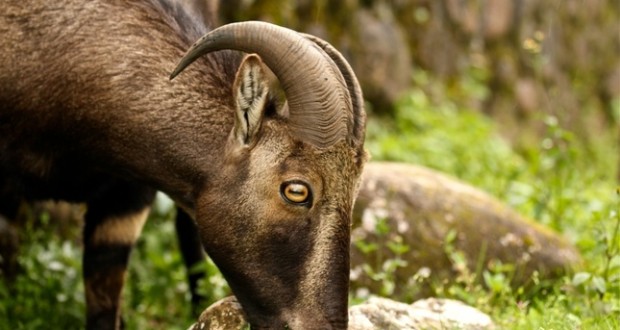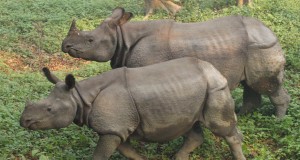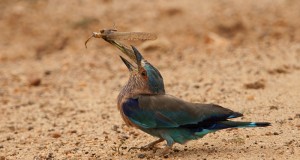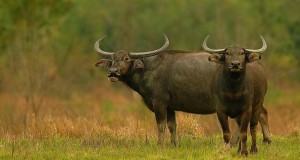Kanha in Madhya Pradesh (five hours driving from Jabalpur, six from Nagpur) has sometimes been called the N’Gorongoro of India. The simile is apt, albeit Kanha is far greener and its cordon of hills far more densely wooded. Unlike Tanzania’s N’ Gorongoro, the Kanha valley is not a volcanic crater, though the enclosing hills are a consequence of geologically ancient volcanic activity. The horseshoe-shaped Kanha valley, which accounts for nearly a third and the oldest part of the Kanha National Park, is bound by two distant spurs emanating from the main Mekal ridge, forming its southern rim. The spurs, in their gently tapering traverse, nearly close in the north leaving but a narrow opening for the meandering Sulkum or Surpan river, the valley’s main drainage. Herds of the Kanha miscellany, the axis deer (chital), the swamp deer (barasingha), the blackbuck ( hiran), the wild pig and occasionally the gaur, throng the central parkland of the valley, providing the basis for the comparison with N’Gorongoro. With its confiding herds and relatively tolerant predators, Kanha offers an almost unrivaled scope to a keen photographer of Indian wildlife.
The forests of the Banjar valley and the Halon valley, respectively forming Kanha’s western and eastern halves, had, 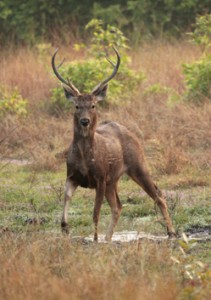 even at the turn of the century, been long famous for their deer and tiger. Expectedly, therefore, they were reserved as the exclusive hunting grounds for the most privileged, the British Viceroy, as early as 1910. The ups and downs in the ensuing decades gave an interesting conservation history to Kanha which celebrated its golden jubilee in 1983. It all started with an area of some 96 sq miles (250 sq km) in the Kanha valley being gazetted as a sanctuary in 1933. This was followed by 116 sq miles (300 sq km) of the Halon valley around Supkhar also being declared a sanctuary in 1935. However, because of extensive deer damage to tree saplings in the forests and crops in nearby villages, the Supkhar sanctuary was denotifled within a few years. Both these areas at that time still harbored teeming populations of the Central Indian barasingha ( Cervus duvauceli branderi). This majestic cousin of the nominate swamp deer (Cervus plains had adapted itself to the hard-ground grasslands and until the turn of the century dominated the Central Indian highlands. Mounting pressures on the wilderness notwithstanding, Kanha valley survived as a sanctuary into the 1950s. Excessive stockgrazing had, however, jeopardized the barasingha’s grassland habitat and its numbers had greatly declined. Yet a few thousand still found a home in Kanha valley’s central maidans — meadows with sporadic groves of trees. Then in the early 1950s, a blessing in cruel disguise, as it were, a privileged hunter was allowed to shoot 30 tigers in and around the sanctuary. The furore that followed led to a special legislation and the Kanha valley was declared a 96-sq-mile national park in 1955. Since then, the gains have been steady. In 1962, the park was expanded to 123 sq miles (318 sq km). In 1970, the area south of the Mekal ridge and down to the river Banjar was added raising it to 172 sq miles (446 sq km). Finally, Project Tiger paved the way for the integration of the eastern Halon valley into the park system, initially on a sanctuary status in 1974 and as a full national park since 1976.
even at the turn of the century, been long famous for their deer and tiger. Expectedly, therefore, they were reserved as the exclusive hunting grounds for the most privileged, the British Viceroy, as early as 1910. The ups and downs in the ensuing decades gave an interesting conservation history to Kanha which celebrated its golden jubilee in 1983. It all started with an area of some 96 sq miles (250 sq km) in the Kanha valley being gazetted as a sanctuary in 1933. This was followed by 116 sq miles (300 sq km) of the Halon valley around Supkhar also being declared a sanctuary in 1935. However, because of extensive deer damage to tree saplings in the forests and crops in nearby villages, the Supkhar sanctuary was denotifled within a few years. Both these areas at that time still harbored teeming populations of the Central Indian barasingha ( Cervus duvauceli branderi). This majestic cousin of the nominate swamp deer (Cervus plains had adapted itself to the hard-ground grasslands and until the turn of the century dominated the Central Indian highlands. Mounting pressures on the wilderness notwithstanding, Kanha valley survived as a sanctuary into the 1950s. Excessive stockgrazing had, however, jeopardized the barasingha’s grassland habitat and its numbers had greatly declined. Yet a few thousand still found a home in Kanha valley’s central maidans — meadows with sporadic groves of trees. Then in the early 1950s, a blessing in cruel disguise, as it were, a privileged hunter was allowed to shoot 30 tigers in and around the sanctuary. The furore that followed led to a special legislation and the Kanha valley was declared a 96-sq-mile national park in 1955. Since then, the gains have been steady. In 1962, the park was expanded to 123 sq miles (318 sq km). In 1970, the area south of the Mekal ridge and down to the river Banjar was added raising it to 172 sq miles (446 sq km). Finally, Project Tiger paved the way for the integration of the eastern Halon valley into the park system, initially on a sanctuary status in 1974 and as a full national park since 1976.

This gives Kanha National Park its present area of 363 sq miles (940 sq km) which is further buffered by an additional area of 388 sq miles (1005 sq km). The total conservation unit encompasses 750 sq miles (1945 sq km) and is called Kanha Tiger Reserve under Project Tiger.
Rich Habitat: Kanha’s topography and geology combine variously to give it its rich habitat diversity. The range of elevation is from 1480 to 2950 feet (450-900 meters) above mean sea level. The bauxite-capped hills sport extensive plateaus, locally called dadar, which carry extensive grasslands with only sparse tree growth. Folds at their fringes, where bauxite yields to basalt, have perennial springs. This combination is an ideal habitat for gaur (Bos gauras), the largest of the world’s cattle, sambar ( Cervus unicolor), the largest of the Indian deer, and chousingha ( Teiraceros quwlricornis), the only four-horned antelope in the world. Nilgai 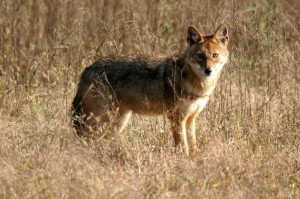 antelope (bluebull) are common here and sloth bear are frequent visitors. You may see a pied or a marsh harrier ( Circus nielanoleucus or C. aeruginosus) hovering in the air and swooping on to a cluster of bush quail (Perdicula asiaiica).The rims of the plateaus have steep rocky slopes and often, escarpments. The latter provide a rare stance for breathtaking views of the valleys below and the hills beyond. Many of these plateaus are large enough for runways and indeed Bamhnidadar, 2780 feet (850 meters) above sea level, on the southeastern rim of the Kanha valley had one operative until I976. A late afternoon visit to Bamhnidadar to see some of these animals is a must. Watching from here the changing hues of the verdant Banjar valley below, against the backdrop of a gradual, glorious sunset, is an enthralling experience indeed.
antelope (bluebull) are common here and sloth bear are frequent visitors. You may see a pied or a marsh harrier ( Circus nielanoleucus or C. aeruginosus) hovering in the air and swooping on to a cluster of bush quail (Perdicula asiaiica).The rims of the plateaus have steep rocky slopes and often, escarpments. The latter provide a rare stance for breathtaking views of the valleys below and the hills beyond. Many of these plateaus are large enough for runways and indeed Bamhnidadar, 2780 feet (850 meters) above sea level, on the southeastern rim of the Kanha valley had one operative until I976. A late afternoon visit to Bamhnidadar to see some of these animals is a must. Watching from here the changing hues of the verdant Banjar valley below, against the backdrop of a gradual, glorious sunset, is an enthralling experience indeed.
The drive down from these plateaus is through exquisite wild country. Huge trees of bija (Plerocarpus tnarsupium), haldu (Adina cardifolia) and dhaora ( Anogeissus laltifolia), along with a host of other large and small trees comprise the thick forests on the slopes. Garlands of massive mahul ( Bauhinia vahlaii) climbers span the spaces between trees. Dense bamboo thickets occupy the(Dendrocata-mustrictus) understory. Much of these mixed forests in such difficult terrain have escaped any form of exploitation and are a picture of raw wilderness.
Sighting the red jungle fowl, the painted spurfowl, a shy barking deer (IMunliacus muntjak) pausing at the roadside glade and some gaur and sambar, is common. What may distinguish such a drive is a leopard hurtling down a tree or one simply walking along the road. Water is generally scarce on the slopes during the dry season. But in the upper reaches of the major nullahs where they flow through gorges carved in basaltic rock, the flow is perennial. There are also some seepage springs scattered amid the slopes. These water holes are the focal points for numerous animals and birds, large and small. In the lower slopes the forest cover changes, often abruptly, from mixed deciduous to lush green sal (Chorea robusta), with or without bamboo.
The valleys with rich alluvium carry a mixed interspersion of stately, near pure, stands of sal and extensive meadows. It is this characteristic parkland appearance of the valleys that typifies the Kanha landscape. The large grassy clearings are a consequence of old, abandoned cultivation, although many have recently come up as a result of a massive village relocation operation under Project Tiger. This important operation was undertaken with great success in order to meet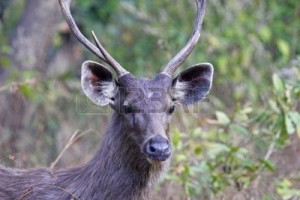 the twin objective of preventing wild animal damage to the crops and cattle of the interior settlements in the park and to release wildlife habitat from human occupation and disturbance in this prime conservation area. Significantly, the operation was smooth and with full involvement of the affected people who were provided adequate and viable alternatives in the form of agricultural land and new organized housing at sites of their choice outside the park. This has been hailed as a major management success of the Kanha National Park in conservation circles, the world over.
the twin objective of preventing wild animal damage to the crops and cattle of the interior settlements in the park and to release wildlife habitat from human occupation and disturbance in this prime conservation area. Significantly, the operation was smooth and with full involvement of the affected people who were provided adequate and viable alternatives in the form of agricultural land and new organized housing at sites of their choice outside the park. This has been hailed as a major management success of the Kanha National Park in conservation circles, the world over.
Kanhas Jewel: The swamp deer or barasingha is the jewel of Kanha and its rescue from the brink of extinction, the crowning glory of its conservation achievements. The enlargement of grassland habitat through village relocation has been the main basis of this breakthrough. Barasingha feed almost exclusively on grasses and tall grass meadows are essential to the security of their fawns from minor and major predators from August – September, when they are dropped, to late November. By this time, the fawns are strong enough to keep pace with the herds and are well initiated into the art of security through herding. Cultivation of the valley grasslands had appropriated the bulk of the grassland habitat while excessive stock grazing did not allow grasses to grow tall enough in the remainder. In consequence, the rate of success at raising young steadily declined and in Kanha valley itself the barasingha number fell from nearly 3000 in the early 1950s to just 66 in I970.This was the last surviving population of this sub- Jackal species in the world. Fortunately, as a result of measures taken, including village relocation, their population continues to show a steady increase and in 1986 had crossed the 500 mark.
With its multitined beams of antlers bent forward and adorned by crowns of grass tufts, the proud carriage of a dominant barasingha stag, silhouetted in profile through mist against sunbeams breaking through stately sal trees on an early winter morning, can be an all-quenching feast to the eyes of a nature lover. Peak winter, December – January, is 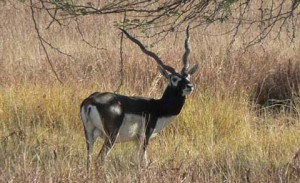 the barasingha’s rutting season and large congregations are seen in the Kanha and Sonph meadows. It is difficult to paint a picture in words of the impressive display of the big breeding stags, the rivalry among them leading to serious fights amid clouds of kicked-up dust, the almost unconcerned females grazing away, the youngsters looking askance, the chase by the victor, the run for life by the vanquished and the finale in the form of the majestic re-entry of the victor into the herd after a thorough wallow in mud. All this, while stag bellows echo from all directions.
the barasingha’s rutting season and large congregations are seen in the Kanha and Sonph meadows. It is difficult to paint a picture in words of the impressive display of the big breeding stags, the rivalry among them leading to serious fights amid clouds of kicked-up dust, the almost unconcerned females grazing away, the youngsters looking askance, the chase by the victor, the run for life by the vanquished and the finale in the form of the majestic re-entry of the victor into the herd after a thorough wallow in mud. All this, while stag bellows echo from all directions.
Blackbuck is not an animal of the moist deciduous forests of the hills or the sal forests of the valleys. Yet the central Kanha meadows carry a small number of blackbuck. It entered Kanha valley from the plains outside, probably with the extension of cultivation along the Sulkum river. Now that the cultivation is gone and the overgrazed short grass meadows are changing over to taller grasses, the blackbuck is facing adversity. Its numbers, near 80 in 1972, had dropped to under 10 in 1986. Jackals, normally scavengers but opportunistic predators, have accentuated the jeopardy. When, following strict protection and intensive conservation measures of the 1970s, all wild animal populations showed a rapid increase, including the most populous chital, the jackal took to hunting the rich crop of chital fawns in the meadows by forming small packs. This opportunistic hunting was extended to blackbuck fawns in the central Kanha meadows from where, unlike chital, they had nowhere else to go. However, in a 69-acre (28-hectare) tiger-leopard-proof enclosure — raised originally for the barasingha — just south of Kanha, their number during the same period has gone up from about five to well over 30.
Shravantal is an ancient, small earthbund tank in the central Kanha meadows. This is an important watering source in the area. It even attracts a fair number of water fowl in winter — mainly the lesser whitling teal, but also to be seen are some common teal, pintail, cotton teal and an occasional shoveler. Sighting Animals: Kanha has a distinct monsoonal climate. Over 90 percent of its annual precipitation of 64 inches (160 cm) arrives between late June and late September. The park remains closed from July Ito October 31, but an early downpour, washing away portions of fair weather roads may enforce an earlier closure (though seldom before June 20). November is mildly cold while December – January are the coldest and given to severe frost, late night temperatures in valleys dipping to 29°F (-2°C). February – March is pleasant spring time.
April starts warming up while May – June is the hottest period. Premonsoon showers in late June kill the 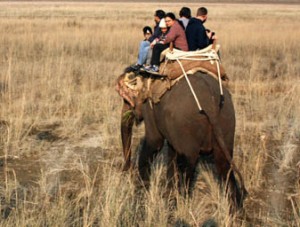 heat and herald massive deer congregations in the naidans, which quickly shed their brown-yellow and don the rich green of the new flush of grasses. This coincides with the second peak of the chital rutting season. Their rut starts in late March and stretches well into July, the first peak being from mid-April to mid-May. The valleys reverberate with loud, sharp and long-drawn bugling of stags. The maidans are dotted with dominant stags displaying to and courting females and fighting rivals for them.
heat and herald massive deer congregations in the naidans, which quickly shed their brown-yellow and don the rich green of the new flush of grasses. This coincides with the second peak of the chital rutting season. Their rut starts in late March and stretches well into July, the first peak being from mid-April to mid-May. The valleys reverberate with loud, sharp and long-drawn bugling of stags. The maidans are dotted with dominant stags displaying to and courting females and fighting rivals for them.
Vehicular excursions and elephant rides in the park are permitted only by daylight. The best time is in early mornings and late afternoons.
Kanha animals are confiding and a little care in approach can yield prolonged pleasure observing interesting animal behavior within a species and interaction among different species. As soon as a group of animals is sighted the vehicle should slow down, and stop at a distance where the animals take note but do not run away.
Soon they resettle, whereafter advances may be made gradually. With patience a vehicle can be positioned between groups of animals on both sides of the road. Vehicles are not allowed to leave the road. Nor is walking allowed while on excursions. The best chances of seeing gaur are at Bamhnidadar in the late afternoons or in the early mornings in the Bishanpura-Sondhar- Ghorella area in the Mukki range. All these areas are good for sighting wild dog (Con alpinus), or dhole (locally called sonha kutta) too. The dhole may also be often seen in Kanha and Sonph maidans. Observing langurs — the species here is Presbyzis enzellus — is absorbing in itself, but their interaction with other herbivores is even more interesting. Langurs are often locally referred to as the chital’s herdsmen because seeing a herd of chital under a tree being foraged by langurs is a common sight.
Chita and, sometimes, also wild boar (Sus scrofa) follow the foraging langurs and greedily feed on the leftovers of fruits and leaves generously thrown to the ground by the latter. The association is further advantageous to the deer and the boar because langurs, from their high stance on trees can see or detect a predator from suspicious movements much earlier than they can and raise the alarm in good time. 
Langurs are quite serious in such observations and seldom sound a false alarm.
Birds: Kanha’s birdlife is rich, the tally of species being close to 300. Mornings are full of rich bird calls. Peafowl, sometimes dancing peacocks during March to June, are seen all over. The Indian roller, racket-tailed drongo, red and yellow wattled lapwing, green bee-eater, different doves (5 species), gray hornbill. tree pie. myna. munia, bushchat, warbler, flycatcher, babbler and woodpecker are commonly seen. Blackheaded and golden oriole, paradise flycatcher, pied Malabar hornbill, Indian pitta, Indian stone curlew, common gray and painted partridge and green pigeon are often seen on drives and elephant rides. Black ibis, white-necked and lesser adjutant storks, white-breasted and pied kingfisher.
different egrets and occasionally cormorants are seen around water bodies or streams near  Kanha, Sonph, Kisli and Mukki. The main birds of prey, often seen swooping down on and catching or feeding on small mammals, snakes and birds, are the crested serpent eagle, crested honey buzzard, whiteeyed buzzard, blackwinged kite, shikra, laggar and shaheen falcon, kestrel and a number of owls and owlets including the barn owl, brown fish owl and the nightjar.
Kanha, Sonph, Kisli and Mukki. The main birds of prey, often seen swooping down on and catching or feeding on small mammals, snakes and birds, are the crested serpent eagle, crested honey buzzard, whiteeyed buzzard, blackwinged kite, shikra, laggar and shaheen falcon, kestrel and a number of owls and owlets including the barn owl, brown fish owl and the nightjar.
Often whitebacked and scavenger vultures and occasionally black and Jongbilled vultures can be seen scavenging on tiger, leopard and wild-dog kills. For bird watchers staying at Mukki, a trek along the Banjar river and for those at Kisli, going round the Kish and Kanha campuses can prove highly rewarding. Penetrating into woodland on foot even around the campus is neither advisable nor permitted for reasons of safety.
Tiger Land: The raw beauty of the Kanha wilderness is satisfying because a comparison of the condition of the forests outside with that of those inside is a strong pointer to “conservation in action” in the Park.
Kanha’s diverse miscellany of mammal and birdlife is without many parallels, because so much is seen so well in so short a time. Yet Kanha is better known as the best place in the world to see tigers. Sighting tigers on drives here is not uncommon, but seeing and photographing tigers from elephant back, sometimes after a thrilling systematic track, is a memorable experience. Elephants usually go out very early in the morning for tiger tracking from Kisli, Kanha or Mukki. An elephant accommodates up to 4 persons besides the mahout — the elephant driver and the friend, philosopher and guide of the visitor.
Starting the track, he would readily say in Hindi, “Eyes, ears and nose open and mouth shut.” This is sound advice and should be heeded in the interest of success in tracking.
With all their senses on the alert, the mahout and his elephant take the visitors to a flattish nultah bed or to a grassy glade amid stately sal trees. Pug marks, drag of a kill, the various vocalizations of the predator, the crowing and shuttling of the crows, the alarm calls of the langur and deer are signs that could lead to a rendezvous with the secretive tiger. The evaluation of these signs enables the mahout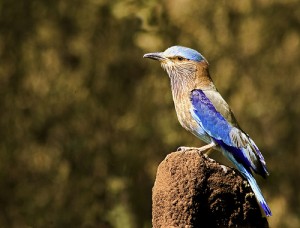 to decide the right course. Usually two to four elephants move together up to this stage and then, after a short conference among the mahouts, each takes an agreed given direction — either down or up a Mullah bank or rustling through the forest, where at the level of the howdah (seating platform on the elephant’s back), the branches of trees and bamboo cuims tend to come together. In an air charged with expectation the mahout will signal the riders to help bend or push the branches away to clear the passage at their level. A mouse deer might dart through the elephant’s legs and the mahout would curse under his breath. His senses keyed to the observation and silent analysis of the signs, at times he might attempt an explanation by gestures. The urgency of the moment commanding, he might, however, move on without waiting to ascertain whether he was understood. A mile or two having thus been covered, the visitors would by then have got into the knack of rocking their body in unison with the elephant’s, for maximum comfort. Then, with birds merrily chirping away, the mahout will suddenly stop in his tracks and peer through the canopy of bamboo, ban-rahar ( Flamingia sop) or sindur ( Mallotus philippinensis ) bushes lower down. He will adjust the elephant’s position for a better view and point out what he had seen — the remains of a kill or the un
to decide the right course. Usually two to four elephants move together up to this stage and then, after a short conference among the mahouts, each takes an agreed given direction — either down or up a Mullah bank or rustling through the forest, where at the level of the howdah (seating platform on the elephant’s back), the branches of trees and bamboo cuims tend to come together. In an air charged with expectation the mahout will signal the riders to help bend or push the branches away to clear the passage at their level. A mouse deer might dart through the elephant’s legs and the mahout would curse under his breath. His senses keyed to the observation and silent analysis of the signs, at times he might attempt an explanation by gestures. The urgency of the moment commanding, he might, however, move on without waiting to ascertain whether he was understood. A mile or two having thus been covered, the visitors would by then have got into the knack of rocking their body in unison with the elephant’s, for maximum comfort. Then, with birds merrily chirping away, the mahout will suddenly stop in his tracks and peer through the canopy of bamboo, ban-rahar ( Flamingia sop) or sindur ( Mallotus philippinensis ) bushes lower down. He will adjust the elephant’s position for a better view and point out what he had seen — the remains of a kill or the un mistakable stripes.
mistakable stripes.
Having made sure of a predator’s presence in the area, he will avoid disturbing it by keeping elephant movements to the minimum. He will whistle a signal to the other elephants who, if around, will carefully approach the area. While awaiting their arrival the mahout will nudge his elephant now and then. Too much movement might scare away the tiger and total lack of it might allow him to slip away.The strategy is to take advantage of the cat’s urge to laze as the day advances. With the arrival of the other elephants, the game of outflanking the tiger, hide and seek, begins and finally the tiger gets reconciled to the elephants’ presence — a bit of a nuisance, but harmless. Sometimes a tiger is sighted within two or three hours, and at others in less than an hour. On some days tigers are sighted at more than one area, on some at none.
But, the game of tracking is thrilling and affords a real feel of the dynamic wilderness, something happening or expected to happen all the time. Many a time a leopard is seen, though unlike the tiger, not for a prolonged view. Other rare sightings may include a monitor lizard, or a porcupine or a python. Of course a host of birds and often gaur, sambar and muntjac are seen too. Once the tiger settles down, it can be viewed for several hours.

